Racing car Suspension
Good handling on the road depends on more than a car’s steering system. The steering works hand in hand with the suspension and tires to create a smooth ride and reliable steering. The suspension acts to improve a car’s ride and handling. Since the first days of motor racing, suspension has been a means to control the tyre on the track and lots of clever geometry and science can predict how this should be done best.
The suspension has several components that work together to accomplish these goals: frame, springs, and damper (shock absorber).
The frame is the rigid structure that supports the main weight of the car. This part of the car is referred to as the sprung mass because it rests on springs. These springs absorb the increased vertical velocity of the wheels as they travel over bumps. The unsprung mass is the weight of the car below the frame: wheels, tires, axles, suspension arms, brakes etc.
The stiffness of the springs affects the performance of the vehicle. If a car is loosely sprung, it will easily absorb bumps in the road, providing a very smooth ride. However, the handling of the car won’t be as good, as the vehicle body will be prone to moving forward, backward, and side to side. Tightly sprung cars, while offering bumpy rides, maneuver more effectively. Car manufacturers aim to find a balance between these qualities.
Springs absorb energy easily; however, they don’t dissipate it so well. As soon as you release a compressed spring, it snaps back in the reverse direction and continues to oscillate until all the energy has been dissipated. If suspensions relied entirely on 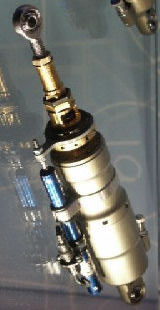 springs, you would have a very bumpy and uncontrollable ride.
springs, you would have a very bumpy and uncontrollable ride.
To account for this, springs are usually paired with dampers, or shock absorbers. These devices use hydraulics to turn kinetic energy (motion) into thermal energy (heat). This way, the energy stored in the spring dissipates quickly, without causing unnecessary motion in the body of the car.
A typical shock absorber is, in essence, a piston inside oil filled tube. The piston is attached to a casing, which is in turn attached to the spring. As the spring moves, it pushes the piston up or down, compressing the oil inside the pressure tube. Tiny valved perforations in the pressure tube allow the oil to slowly escape into the reserve cylinder. The system is designed to provide enough resistance to absorb all of the energy from the spring without moving too much.
Today in all modern car, independent suspensions, in which the wheels are each allowed to move on their own is used. If both the front and the back wheels use an independent suspension, then a car can be said to have four-wheel independent suspension. One of the most common designs used on the front suspension is the McPherson strut, which is named after its inventor, Earle S. McPherson of General Motors. Invented in 1947, this design is still common today.
Another common design for front suspensions is the double wishbone or double A arm suspension. In this design, two wishbone (Y) shaped supports are attached to each wheel, joining the wheel at one point and the frame at two points.
Each of these basic designs has been modified in a number of different ways to produce a range of suspension options. All of these designs, however, employ the same basic principles to produce a safe and comfortable ride.
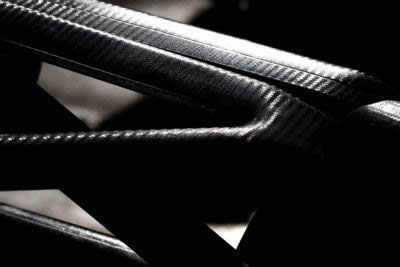
From the early 1960s to the present day virtually all serious racing cars have used the classic double wishbone suspension arrangement or a close variation of that.
This type of suspension has the advantages of light weight, impressive strength and a well-controlled ride. The purpose of a F1 Car's (and any car) suspension is to keep all four wheels glued to the track despite aberrations in the pavement. A racing car's suspension also has to be lightweight, compact and, in any serious open wheel racing class, aerodynamically well designed.
F1 cars operate substantially similar suspension front and rear,the packaging varies each end but the main components are the same.
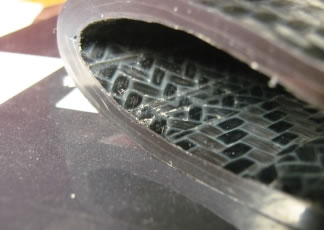 |
Cutout of one of suspension arms. To make it lighter, arm is hollow and trough the "tube" designers can now pass different auxiliary control wires and everything needed around brakes and wheels. |
An F1 car has a very small degree of suspension travel compared to a road car. Its purposes are not just to make the car ride well over bumps, but to improve traction and aid aerodynamic performance. Aerodynamics play huge role in Formula 1 and all external parts of suspension are designed by aerodynamicist, since the wake of air coming off them has a such important role in airflow management. They have to handle huge aero loads coming from the car body and hold the chassis in the correct height relative to the track to harvest a last bit of downforce. Because of this huge loads, elements are made of carbon fibre composites. If a constant ride height can be maintained the car’s aerodynamics work better. That's why Mercedes AMG F1 team and Lotus F1 team introduced so called FRIC (Front and Rear Inter-Connected) suspension system which has helped Lotus E21 and Mercedes W04 to reach competitively during 2013 season.
Racing driver brake deep into the corner and it's generally in this combined conditions (braking and steering) that we can see highest loads. Add a bumps into equation and we can see a loads approaching 30 tones. Suspensions must handle this loads repeatedly without failure. A suspension designer can influence this loads in way they are distributed trough the various legs of the wishbone. Unfortunately, geometry that favours aerodynamics rarely present good geometry from a load point of view. So, in performance terms, rigidity is as much important. It's have no sense to spend months and million of dollars to ensure perfect geometry, and then flexing of some part of the system trow ideal geometry far from desired.
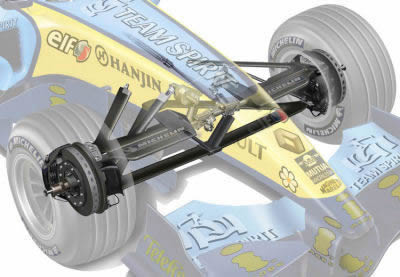
The front suspension consists of two triangular supports (wishbones) that mount to the front hubs. The springs and shocks, as well as the equivalent of the anti-roll bar, are all mounted inside nose cone, just in front of the driver legs.
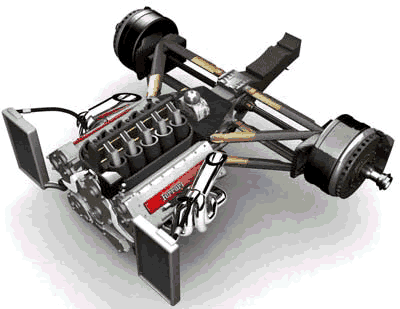
The rear suspension is similar to the front by design. The main differences are the lack of the steering mechanism, the addition of the drive shaft and the greater weight that the rear suspension must carry. The springs and shocks follow an arrangement similar to the front suspension, but they are larger and fold alongside or inside the gearbox.
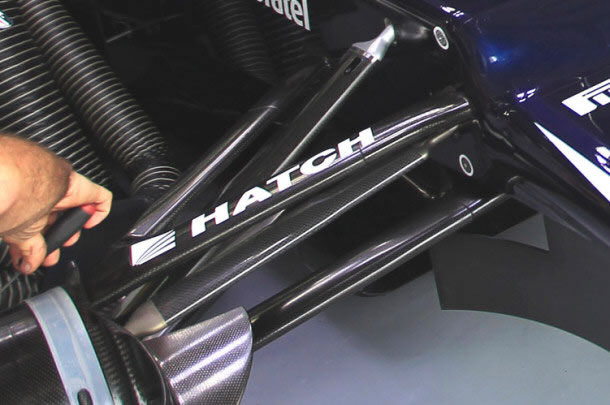
Double wishbones control the wheels attitude and from the outer end of the wishbone, a rod controls a rocker that then activates the various elements that control the suspensions compliance. Firstly the springs are in the form of torsion bars, these are like straightened coil springs and their resistance to twist provides the springing medium to support the cars mass. Dampers, one for each wheel, control the movement of the wheel as it raises and falls (bump and droop). The antiroll bar controls the amount of weight transfer from one side of the car to the other. Lastly the third spring, also known as a heave damper control the pitch movement (both wheel bump or droop simultaneously) This is especially important to prevent the downforce load pressing the car against the track and bottoming the car on the ground at high speed. Teams may also fit an inerter in this position to offset the uncontrolled bounce of the tires having an effect on the chassis.
Geometry of the suspension must be keeped as ideal as possible to exploit the tires. The beauty of double wishbone suspension arrangement is that by carefully design of the pivot points (points on which suspension arms rotate) and arm lengths, the camber of the wheel can be maintained close to the optimum even while the body rolls during cornering.
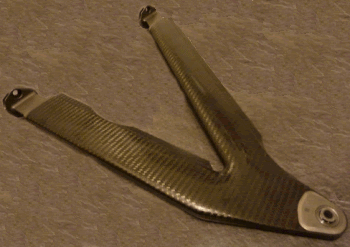 Not only that but the roll centre - a term for the abstract point around which the car rolls when cornering - can be held consistent, helping to race with the car with stable handling characteristics. Then there are ways of further refining the handling characteristics by angling the axes of the wishbones in various ways. For instance wheel toe-in, camber angle and castor angle can be made to vary with body roll to enhance steering feel, or upward (bound) suspension deflection can be made to act against the forward weight transfer under braking to oppose front end dip. This is known as anti-dive and a similar arrangement in reverse, known as anti-squat, can be applied at the rear.
Not only that but the roll centre - a term for the abstract point around which the car rolls when cornering - can be held consistent, helping to race with the car with stable handling characteristics. Then there are ways of further refining the handling characteristics by angling the axes of the wishbones in various ways. For instance wheel toe-in, camber angle and castor angle can be made to vary with body roll to enhance steering feel, or upward (bound) suspension deflection can be made to act against the forward weight transfer under braking to oppose front end dip. This is known as anti-dive and a similar arrangement in reverse, known as anti-squat, can be applied at the rear.
 In recent years, suspension members have been streamlined into an aerofoil shape. According to the rules however, they are not allowed to produce downforce, and are simply shaped that way to reduce drag, and to keep the flow heading for the sidepods relatively undisturbed. The suspension arms are a good example, as they are often made in a shape of a wing, although the upper surface must be identical to the lower surface. This is done to reduce the drag on the suspension arms as the car travels through the air at high speed. Diagram A, represents an unstreamlined suspension arm, and the lower one, B, a suspension arm with an aerodynamic covering. Both have roughly the same cross sectional area, but the B has a drag force ten times less than A.
In recent years, suspension members have been streamlined into an aerofoil shape. According to the rules however, they are not allowed to produce downforce, and are simply shaped that way to reduce drag, and to keep the flow heading for the sidepods relatively undisturbed. The suspension arms are a good example, as they are often made in a shape of a wing, although the upper surface must be identical to the lower surface. This is done to reduce the drag on the suspension arms as the car travels through the air at high speed. Diagram A, represents an unstreamlined suspension arm, and the lower one, B, a suspension arm with an aerodynamic covering. Both have roughly the same cross sectional area, but the B has a drag force ten times less than A.
The new development during 2013 season is the FRIC suspension. FRIC stands for Front and Rear Interlinked suspension, which is being used by Mercedes and Lotus as far as I can tell. The basic principle behind FRIC suspension is to essentially keep the car at a constant ride height under braking, acceleration and during cornering. With Rake being ever important to the cars aero set up, such linked systems are increasingly being investigated by the teams. To know more about FRIC check my article here.






